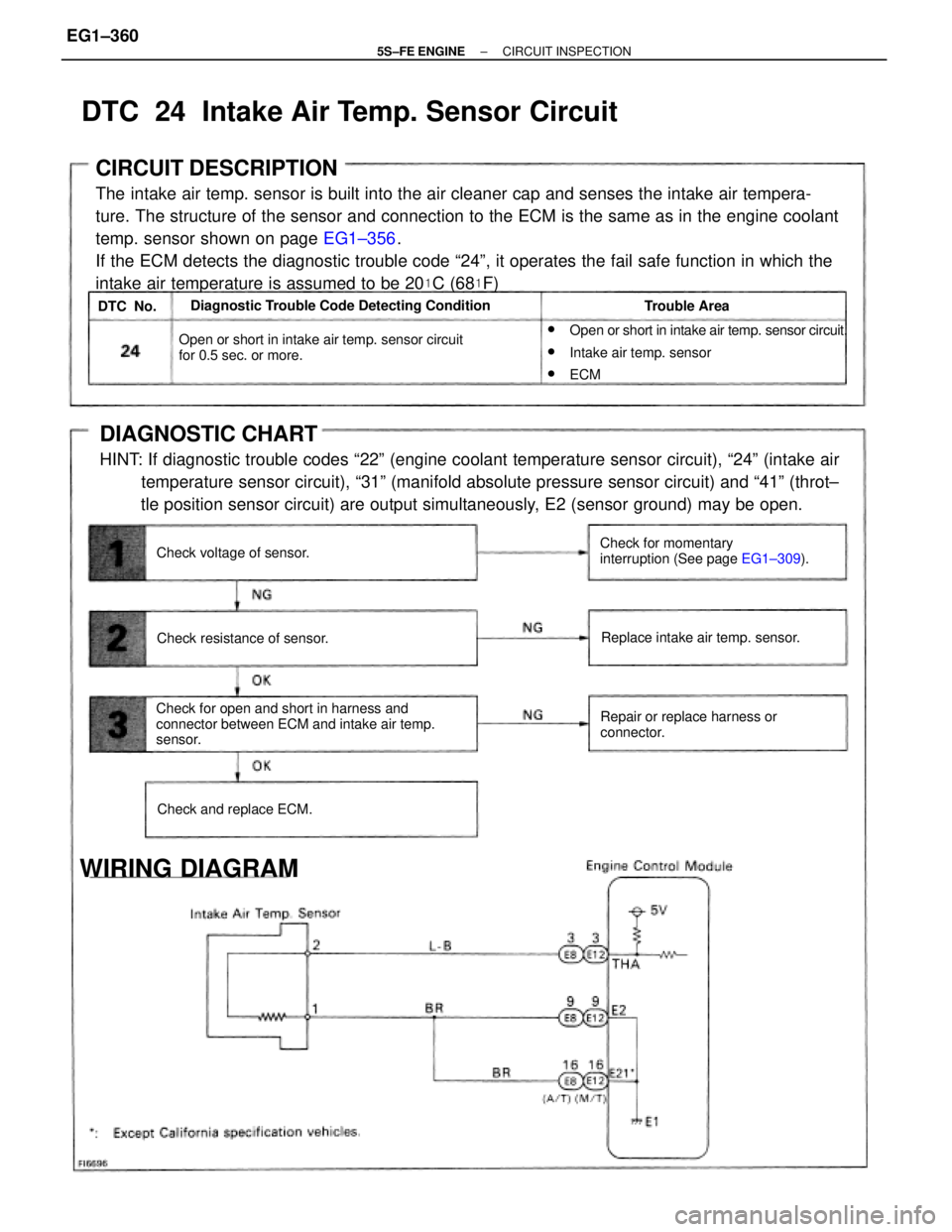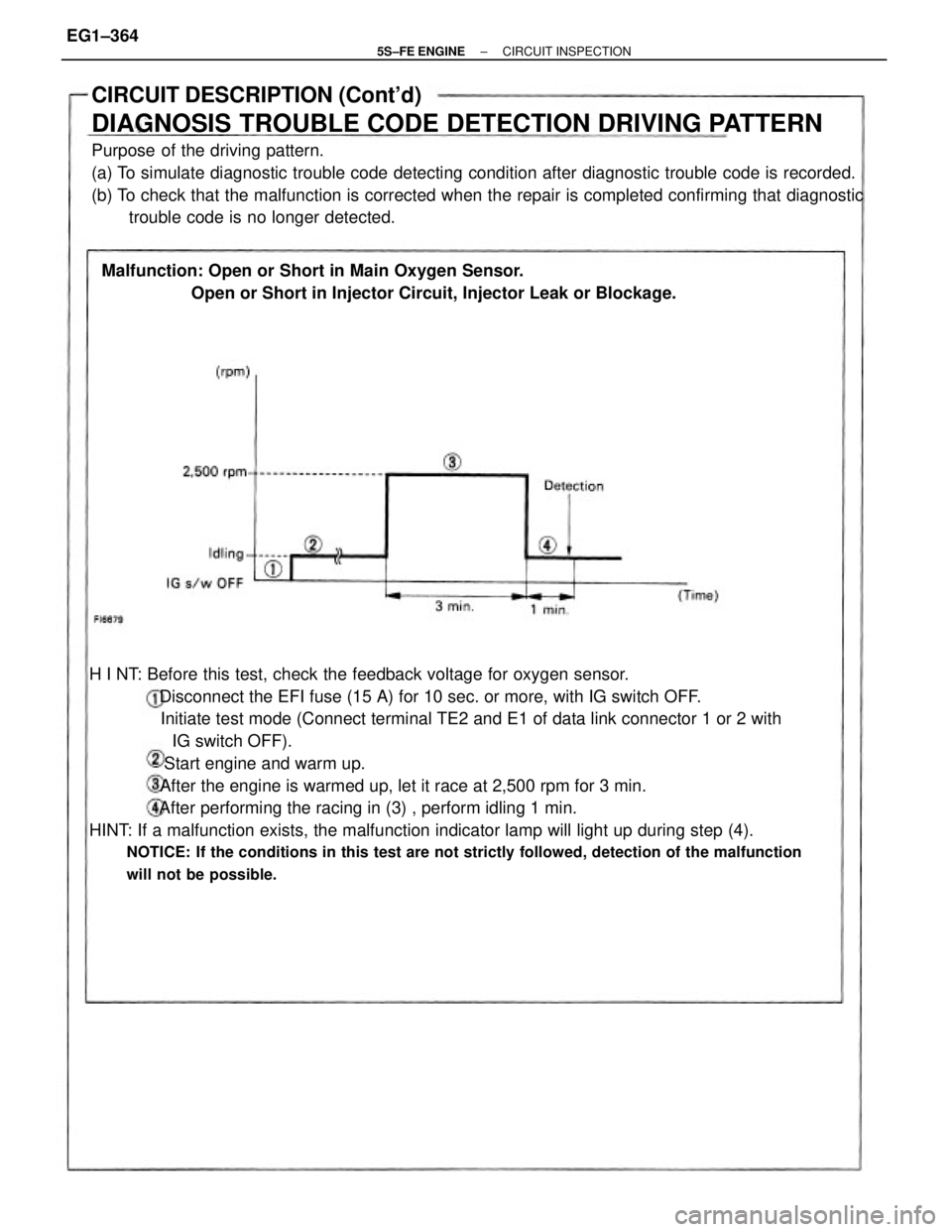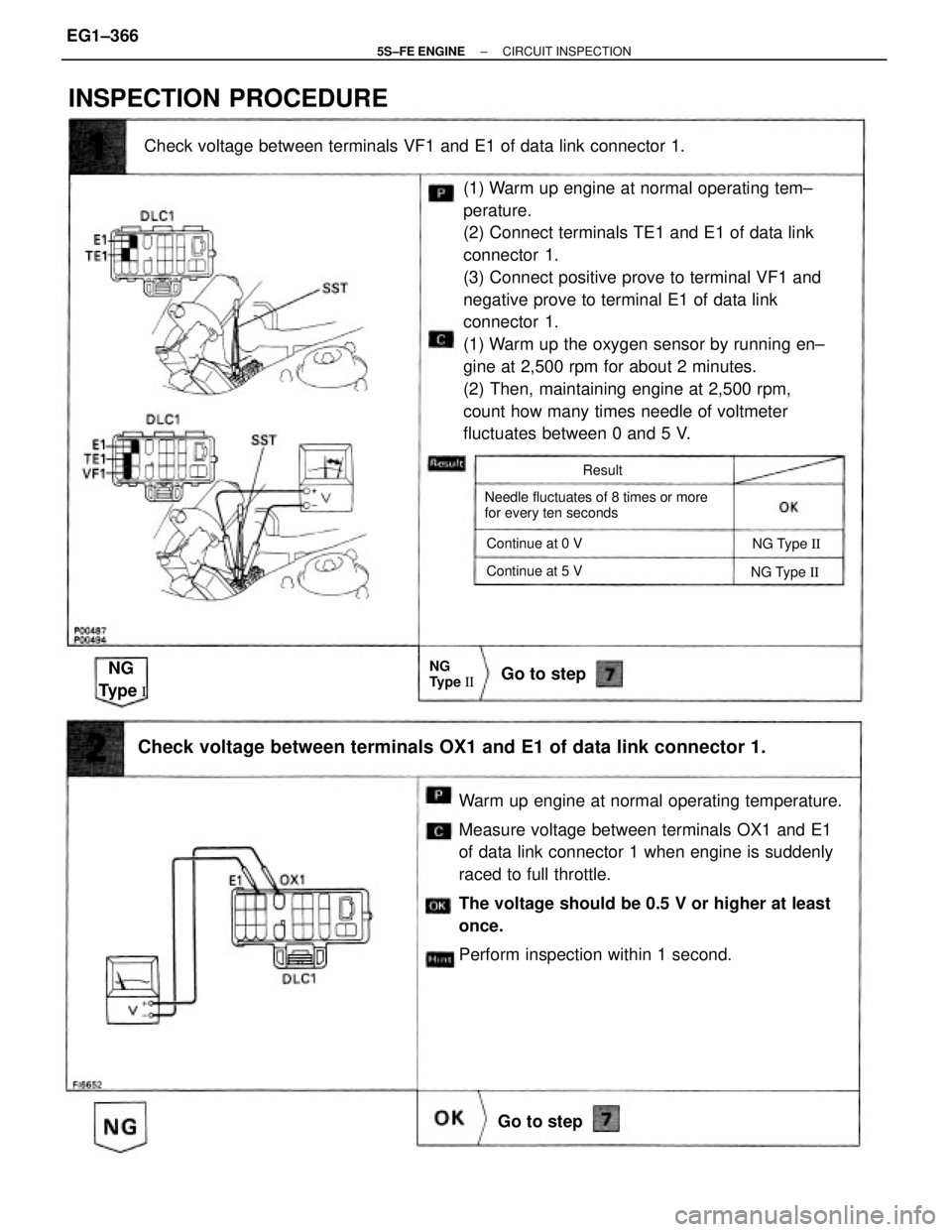Page 410 of 4770

DIAGNOSTIC CHART
HINT: If diagnostic trouble codes ª22º (engine coolant temperature sensor circuit), ª24º (intake air
temperature sensor circuit), ª31º (manifold absolute pressure sensor circuit) and ª41º (throt±
tle position sensor circuit) are output simultaneously, E2 (sensor ground) may be open.
CIRCUIT DESCRIPTION
The intake air temp. sensor is built into the air cleaner cap and senses the intake air tempera-
ture. The structure of the sensor and connection to the ECM is the same as in the engine coolant
temp. sensor shown on page EG1±356.
If the ECM detects the diagnostic trouble code ª24º, it operates the fail safe function in which the
intake air temperature is assumed to be 20
�C (68�F)
w
Open or short in intake air temp. sensor circuit.
wIntake air temp. sensor
wECM
Check for open and short in harness and
connector between ECM and intake air temp.
sensor.Open or short in intake air temp. sensor circuit
for 0.5 sec. or more.
Check for momentary
interruption (See page EG1±309). Diagnostic Trouble Code Detecting Condition
Repair or replace harness or
connector.Replace intake air temp. sensor.
WIRING DIAGRAM
Check resistance of sensor.
Check and replace ECM. Check voltage of sensor.Trouble Area
DTC 24 Intake Air Temp. Sensor Circuit
DTC No.
± 5S±FE ENGINECIRCUIT INSPECTIONEG1±360
Page 411 of 4770
(1) Remove glove compartment.
(See page EG1±234)
(2) Turn ignition switch on.
Measure voltage between terminals THA and E2
of engine control module connector.
Check voltage between terminals THA and E2 of engine control
module connector.
Check for momentary interruption
(See page EG1±309).
INSPECTION PROCEDURE
Intake air temp.
5C (5F)
0.5 ~ 3.4 V
0.2 ~ 1.0 V
60 (140)20 (68)Voltage
± 5S±FE ENGINECIRCUIT INSPECTIONEG1±361
Page 412 of 4770
Check for open and short in harness and connector between
engine control module and intake air temp. sensor (See page IN±31).
Disconnect the air temp. sensor connector.
Measure resistance between terminals.
Resistance is within Acceptable Zone on chart.
Check intake air temp. sensor.
Check and replace engine control module.Repair or replace harness or connector.Replace intake air temp. sensor.
Intake air temp.
5C (5 F)
0.4 ± 0.7 k
�
Resistance
60 (140)20(68)
2 ±3k
�
± 5S±FE ENGINECIRCUIT INSPECTIONEG1±362
Page 414 of 4770

H I NT: Before this test, check the feedback voltage for oxygen sensor.
Disconnect the EFI fuse (15 A) for 10 sec. or more, with IG switch OFF.
Initiate test mode (Connect terminal TE2 and E1 of data link connector 1 or 2 with
IG switch OFF).
Start engine and warm up.
After the engine is warmed up, let it race at 2,500 rpm for 3 min.
After performing the racing in (3) , perform idling 1 min.
HINT: If a malfunction exists, the malfunction indicator lamp will light up during step (4).
NOTICE: If the conditions in this test are not strictly followed, detection of the malfunction
will not be possible.
CIRCUIT DESCRIPTION (Cont'd)
DIAGNOSIS TROUBLE CODE DETECTION DRIVING PATTERN
Purpose of the driving pattern.
(a) To simulate diagnostic trouble code detecting condition after diagnostic trouble code is recorded.
(b) To check that the malfunction is corrected when the repair is completed confirming that diagnostic
trouble code is no longer detected.
Malfunction: Open or Short in Main Oxygen Sensor.
Open or Short in Injector Circuit, Injector Leak or Blockage.
± 5S±FE ENGINECIRCUIT INSPECTIONEG1±364
Page 415 of 4770
WIRING DIAGRAM
Refer to page EG1±354 for the WIRING DIAGRAM.
Does malfunction disappear when a good main
oxygen sensor is installed?Check each item found to be a possible cause
of problem.
Does malfunction disappear when a good main
oxygen sensor is installed?Check each item found to be a possible cause
of problem.Check for open and short in harness and
connector.Repair or replace harness or
connector.
DIAGNOSTIC CHART
Check voltage of terminal OX1.Check voltage of terminal VF1.
Replace main oxygen sensor.
Replace main oxygen sensor. Check and replace ECM.
Check and replace ECM.Check compression.
Check compression.Repair or replace.
Repair or replace.Repair or replace.
Repair or replace.N G TypeII
NG Type I
YESYES
± 5S±FE ENGINECIRCUIT INSPECTIONEG1±365
Page 416 of 4770

(1) Warm up engine at normal operating tem±
perature.
(2) Connect terminals TE1 and E1 of data link
connector 1.
(3) Connect positive prove to terminal VF1 and
negative prove to terminal E1 of data link
connector 1.
(1) Warm up the oxygen sensor by running en±
gine at 2,500 rpm for about 2 minutes.
(2) Then, maintaining engine at 2,500 rpm,
count how many times needle of voltmeter
fluctuates between 0 and 5 V.
Warm up engine at normal operating temperature.
Measure voltage between terminals OX1 and E1
of data link connector 1 when engine is suddenly
raced to full throttle.
The voltage should be 0.5 V or higher at least
once.
Perform inspection within 1 second.
Check voltage between terminals OX1 and E1 of data link connector 1.
Check voltage between terminals VF1 and E1 of data link connector 1.
Needle fluctuates of 8 times or more
for every ten seconds
INSPECTION PROCEDURE
Continue at 0 V
Continue at 5 V
NG
Type II
Go to stepGo to step NG
Type
ING Type II
NG Type II Result
± 5S±FE ENGINECIRCUIT INSPECTIONEG1±366
Page 417 of 4770

Check each circuit found to be a possible cause of trouble according to the results of the check in
or . The numbers in the table below show the order in which the checks should be performed.Check for open and short in harness and connector between engine control module and
main oxygen sensor, engine control module and data link connector 1 (See page
IN±31).
Does malfunction disappear when a good main oxygen sensor is
installed?Check each item found to be a possible cause of problem.
Check compression (See page EG1±23).
Repair or replace harness or connector.
Check and replace engine control module.
Characteristics deviation in
manifold absolute pressure sensor.
Characteristics deviation
in engine coolant temp. sensor.
Replace main oxygen sensor.
*: Except California specification vehicles.Characteristics deviation
in intake air temp. sensor. Main oxygen sensor
signal continue at OV.
Repair or replace.
Repair or replace.
Faulty sensor installation.Possible Cause
Injector circuit
Valve timing
Fuel system Air leakageSee page
IG±6, 26*
YES
EG1±410
EG1±360 EG1±419
EG1±372 EG1±173
EG1±356 Misfire
EG1±36
± 5S±FE ENGINECIRCUIT INSPECTIONEG1±367
Page 418 of 4770
Check each circuit found to be a possible cause of trouble according to the results of the check in
.The numbers in the table below show the order in which the checks should be performed.
Does malfunction disappear when a good main oxygen sensor is
installed? Check each item found to be a possible cause of problem.
Check compression (See page EG1±23).
Check and replace engine control module.
Characteristics deviation
in engine coolant temp. sensor.
Characteristics deviation in
manifold absolute pressure sensor.
Replace main oxygen sensor.
Main oxygen sensor
signal continue at 5.0 V.
x: Except California specification vehicles.Characteristics deviation
in intake air temp. sensor. Main oxygen sensor
signal is normal.
Repair or replace.
Repair or replace.
Possible Cause
Injector circuit
Valve timing
Fuel system Air leakageSee page
IG±6, 26*
YES
EG1±410
EG1±360 EG1±419
EG1±372 EG1±173
EG1±356 Misfire
EG1±36
± 5S±FE ENGINECIRCUIT INSPECTIONEG1±368